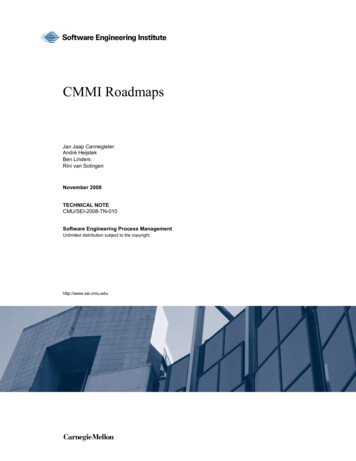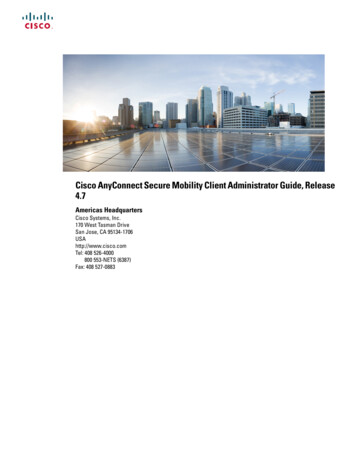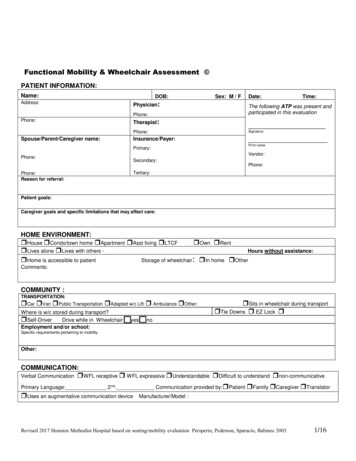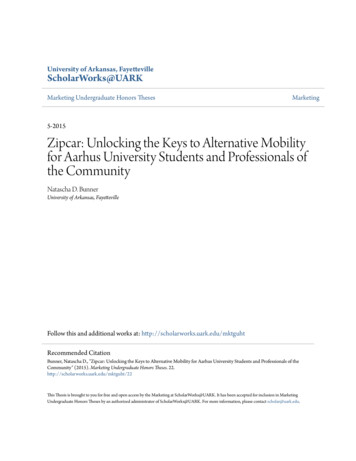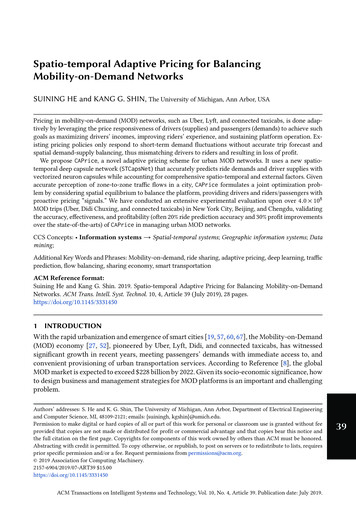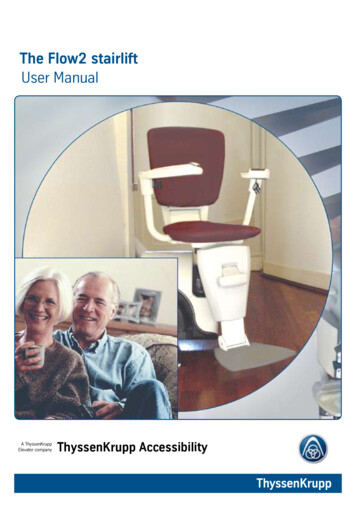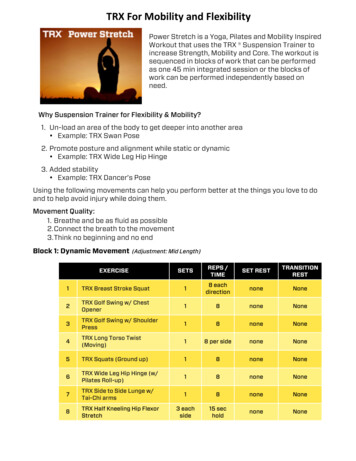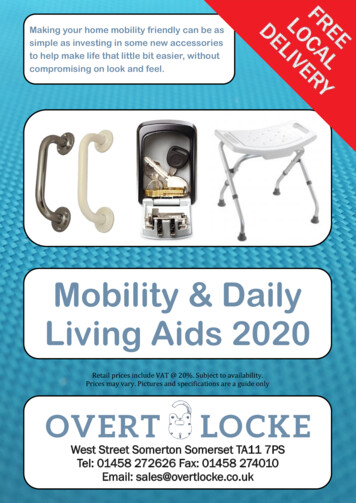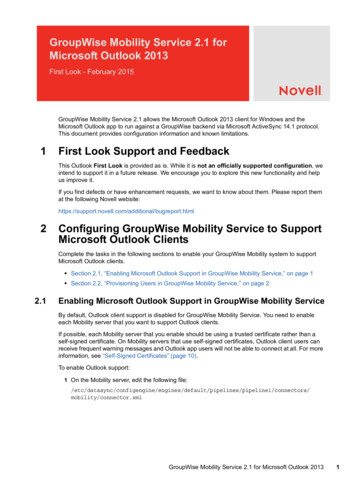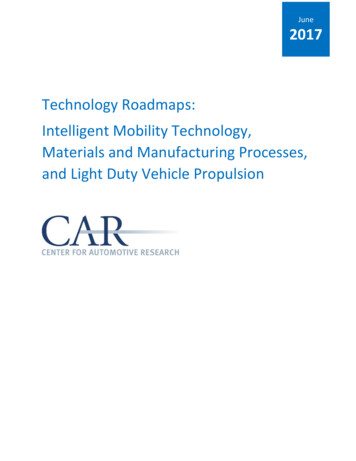
Transcription
June2017Technology Roadmaps:Intelligent Mobility Technology,Materials and Manufacturing Processes,and Light Duty Vehicle Propulsion
AcknowledgementsThis whitepaper provides a summary of a more extensive body of work produced by the Center forAutomotive Research for Innovation, Science and Economic Development Canada (ISED). The authors ofthe detailed body of work, and whitepaper would like to thank our colleagues Kristin Dziczek, RichardWallace, Mark Stevens, Bernard Swiecki, Eric Paul Dennis, Dave Andrea, and Jay Baron for their inputand guidance throughout this project. Additional assistance was provided by Diana Douglass, whocoordinated the production of this document and Shaun Whitehouse who created the infographics.Brett Smith, Assistant Director of Manufacturing, Engineering, and TechnologyAdela Spulber, Transportation Systems AnalystShashank Modi, Research EngineerTerni Fiorelli, Industry Analyst3005 Boardwalk, Suite 200Ann Arbor, MI 48108www.cargroup.orgThe Center for Automotive Research, a nonprofit automotive research organization, has performeddetailed studies of the contribution of the automotive industry and its value chain in the U.S. economyfor more than 35 years.CAR’s mission is to conduct independent research and analysis to educate, inform and advisestakeholders, policy makers, and the general public on critical issues facing the automotive industry, andthe industry’s impact on the U.S. economy and society.For citations and reference to this publication, please use the following:Smith, Brett, Adela Spulber, Shashank Modi, and Terni Fiorelli. (2017). Technology Roadmaps: IntelligentMobility Technology, Materials and Manufacturing Processes, and Light Duty Vehicle Propulsion. Centerfor Automotive Research, Ann Arbor, MI.1
Table of ContentsAcknowledgements.1Table of Figures.3Introduction .4Intelligent Mobility Technologies.4The World We Know . 4Drivers of Change, Technological and Otherwise. 5The World on the Horizon. 5Enablers and Threats . 10Monitoring the Future . 11Materials and Manufacturing Technologies . 11The World We Know . 12The World on the Horizon. 13Enablers and Threats . 16Monitoring the Future . 18Light Duty Vehicle Propulsion . 19The World We Know . 19The World on the Horizon. 20Enablers and Threats . 24Monitoring the Future . 24Conclusion . 252
Table of FiguresFigure 1: Roadmap for Advanced Driver Assistance Systems and Vehicle Automation Technologies . 6Figure 2: Timeline for Launches of Advanced Driver Assistance Systems and Automated Driving Features. 7Figure 3: Timeline for Vehicle Connectivity Technologies . 8Figure 4: Roadmap for New Mobility Services and Vehicle Automation Technologies . 9Figure 5: Growth Projections for Carsharing and Ridehailing . 9Figure 6: Global General Timeline . 11Figure 7: Materials Used Most Commonly for Major Vehicle Structure Components in the Current Fleet. 12Figure 8: Current Vehicle Material Mix Based Upon 14 Major Components from 42 Mass ProducedVehicles. 13Figure 9: Material Distribution in the U.S. Fleet (Body-in-White Plus Closures), 2010 to 2040 . 14Figure 10: Emerging Manufacturing Processes and Enablers for Growth, 2015 to 2035 . 15Figure 11: Trends in Joining Processes, Current Year to Beyond 2030. 16Figure 12: Drivers for Material Technology Change . 17Figure 13: Challenges to Address for Faster Introduction of New Materials . 18Figure 14: Internal Combustion Engine (ICE) Technologies. 21Figure 15: Electrified Vehicle Technology Pathways . 22Figure 16: Advanced Battery Development Trends . 23Figure 17: North American and Global Light Duty Vehicle Propulsion Technology Market Penetration2015-2030. 243
IntroductionMajor technological advances to both products and manufacturing processes are acceleratinginnovation throughout the automotive industry. To capture the scope of these technologies, the Centerfor Automotive Research (CAR) was called upon by Innovation, Science and Economic DevelopmentCanada (ISED) to develop and validate a technology roadmap for the automotive sector. This roadmapprovides a broad understanding of technology trends throughout the industry from current year tobeyond 2030.CAR identified and reviewed over a hundred existing roadmaps published by consulting firms,independent think tanks, trade journals, and CAR’s own research. CAR also conducted literaturesearches and reviewed announcements at key industry events to identify any emerging technologiesthat were not covered in existing roadmaps. Based on the information gathered, CAR synthesized theresearch and existing roadmaps into three groups: Intelligent Mobility Technology; Materials andManufacturing Processes; and Light Duty Vehicle Propulsion. Once these synthesized technologyroadmaps were developed, CAR convened a roundtable of 25 experts from each of the technologygroups to validate the findings.This whitepaper synthesizes the results from the technology roadmap project conducted for ISED andadds further interpretation of the challenges and concerns related to the projected technology andmanufacturing trends.Intelligent Mobility TechnologiesAdvances in connectivity, automation, and new mobility services are powerful agents of changeaffecting the automotive industry, the larger transportation sector, and beyond. To better assess thepotential and likely directions and magnitude of change, the Center for Automotive Research (CAR)developed a “technology roadmap” that reflects input from a wide array of industry experts. Thisroadmap is the result of CAR’s in-house research, completed by a critical analysis of reports from leadingconsulting firms, investment banks, and universities and validated by select industry leaders andstakeholders. While there is an overall consensus on the direction and nature of changes through whichthe industry is going, a great deal of uncertainty remains in predicting specific timeframes.The World We KnowVehicle automation, connectivity, and mobility encompass trends in technology and business modelsthat have been in motion for decades; however, in the last five to 10 years, the transportation sectorhas witnessed an acceleration in technology development and strategy decisions. In this period,automated vehicle systems that influence the lateral or longitudinal (or both) motion of a vehicle,including applications such as automated park assist, adaptive cruise control, and automated emergencybraking, have become available on an increasing number of new vehicles. Eventually, this trend isexpected to culminate in fully automated (i.e., SAE Level 5 1) vehicles. In a parallel evolutionary track,numerous advanced driver assistance systems (ADAS) that warn, aid, and assist drivers were introduced1SAE International, a global association of engineers and related technical experts in the aerospace, automotiveand commercial-vehicle industries, has defined six levels of levels of automation for on-road motor vehicles thatare detailed in the J3016 standard. Level 5, Full Automation, is defined as “the full-time performance by anAutomated Driving System of all aspects of the dynamic driving task under all roadway and environmentalconditions that can be managed by a human driver.”4
in 2000-2010 on higher-end vehicles. ADAS serve to automate specific vehicle systems for improvedsafety and better driving, though a human driver remains in command.Vehicle connectivity covers a wide variety of functional systems, from telematics and infotainment tovehicle-to-vehicle (V2V) and vehicle-to-infrastructure (V2I) communications focused on cooperative,active safety. In recent years, great progress has been made developing and testing V2V and V2Iequipment and applications, and regulatory rule-making has us on the brink of a V2V mandate.New mobility services (NMS) provide entirely new business models or reshape existing models withtechnology, such as ridehailing linked to for-hire vehicles or ridesharing linked with carpooling.Generally, NMS are enabled by emerging technology platforms and wireless connectivity that allow formore convenient, efficient, and flexible travel. Their beginnings can be placed roughly in the 1990s. Realgrowth occurred in the 2010s when the number of different concepts (or business models) andcompanies increased substantially; NMS are especially appealing in dense urban areas.Drivers of Change, Technological and OtherwiseIntelligent mobility technologies are enabled by several recent technology innovations, including digitalcellular networks, powerful computer processors, various sensors (including GPS), data fusion, andmachine learning. Automotive manufacturers are always on the look-out for innovative technologies todifferentiate their products. Intelligent mobility technologies will be increasingly important in themarketing of new vehicles, as well as nurturing relationships with consumers. Automotivemanufacturers and tech companies big and small have engaged in a race towards the development ofthese technologies, and automakers are now competing with new players in the emerging mobilityindustry to remain relevant and innovative. Automakers are particularly interested in connectivity,automation, and ADAS, because they offer car buyers new solutions for safety and convenience, andsuch features can increase the profit margin of vehicle sales and offer new revenue streams.Consumers’ desire for seamless, reliable, and convenient transportation has been crucial for the rapidgrowth of ridehailing, but this same desire also underpins new mobility services such as carsharing,ridesharing, and microtransit. Ridehailing and carsharing companies are disrupting the transportationsector by providing more ways to have access to vehicles without ownership. Automakers are hedgingtheir bets against these disruptors by testing new business models themselves, seeking to go beyond theold models of selling cars to individuals and developing new mobility services in-house.The World on the HorizonNorth American, European, Israeli, and Japanese companies are leading the development of automatedvehicles, but Chinese companies are accelerating their efforts and quickly catching up. Furthermore,tech companies and startups are disrupting traditional supply chains by developing software, chipsets,and sensors for automated vehicles
developed a “technology roadmap” that reflects input from a wide array of industry experts. This roadmap is the result of AR’s in-house research, completed by a critical analysis of reports from leading consulting firms, investment banks, and universities and validated by select industry leaders and stakeholders. While there is an overall consensus on the direction and nature of changes through which
